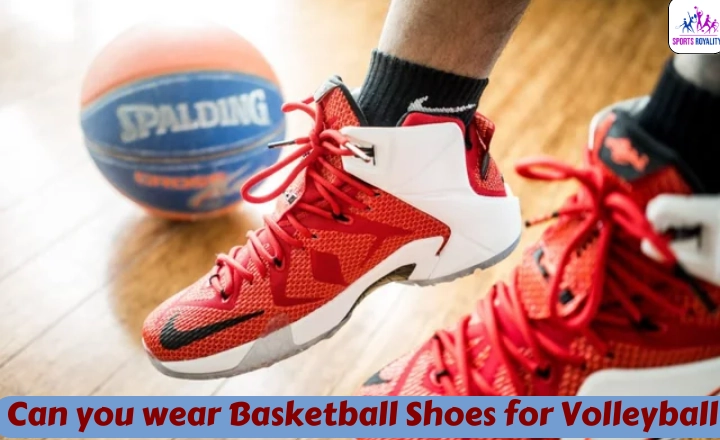Basketball and volleyball are exciting sports requiring quick movements, agility, and explosive jumps. While each sport has specific footwear designed to enhance performance and prevent injuries, is it possible to interchange basketball shoes for volleyball?
Many athletes wonder if they can use their basketball sneakers on the volleyball court and whether these shoes provide the necessary support and stability. We will explore the similarities and differences between basketball and volleyball shoes and search the answer Can You Wear Basketball Shoes For Volleyball?
Are Volleyball & Basketball Shoes The Same?
While there may be some similarities between volleyball and basketball shoes, they are different. Both sports require quick movements, lateral stability, and good traction on the court. Each sport has different demands that affect shoe design.
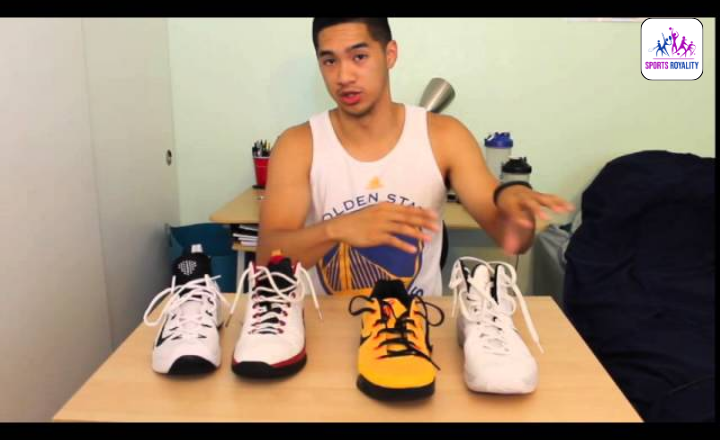
Volleyball players need shoes with excellent cushioning to absorb impact during jumps and landings. They also require a lightweight, breathable upper to ensure agility and prevent overheating during long matches.
Both volleyball and basketball shoes share some fundamental characteristics such as traction, durability, and comfort; their specific designs cater to the unique demands of each sport.
While volleyball focuses on cushioning for jumps and agility in movement, basketball emphasizes ankle support due to its intense directional changes. Understanding these differences can help athletes make informed choices when selecting the appropriate footwear for their chosen sport.
Volleyball Shoes Are Evolving Into Basketball Shoes
Volleyball shoes have come a long way since the days of simple, low-profile designs. With the release of the Nike React Hyper set, it’s clear that volleyball shoe manufacturers are taking cues from the basketball shoe industry.
The Hyper set boasts an outsole and midsole that are virtually carbon copies of those found on high-performance basketball shoes.
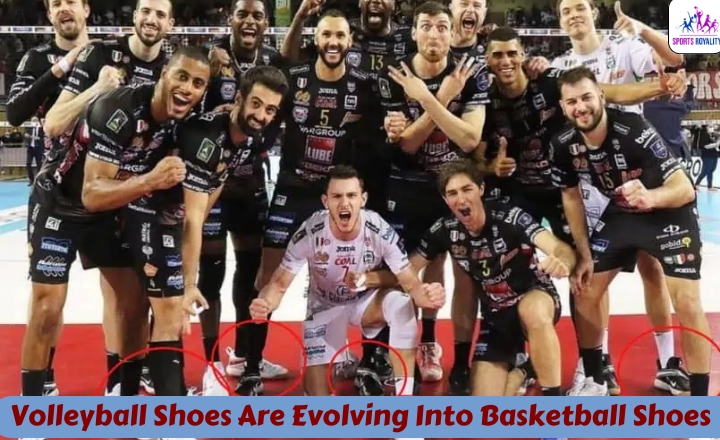
This evolution in design reflects a growing trend in volleyball towards more explosive movements and increased verticality. Players are no longer content with simply having stable footing on the court; they want to be able to jump higher and move faster than ever before.
By incorporating aspects of basketball shoe design, such as the responsive cushioning and support systems that help propel players off the ground, brands like Nike cater to these evolving player demands.
This shift towards basketball-inspired design also speaks to the changing nature of modern volleyball. As teams increasingly emphasize speed and agility over traditional power play, footwear technology has had to adapt accordingly.
The Nike React Hyper set is just one example of how volleyball shoes are embracing this shift towards a more dynamic style of play. With every new release pushing boundaries further, you can expect even more innovations in footwear technology as volleyball transforms into a faster-paced game resembling its hardwood cousin, basketball.
Why You Should Wear Basketball Shoes for Volleyball?
There is a growing trend among top athletes to wear basketball shoes on the court, and for good reason. Basketball shoes offer ankle support and cushioning that can significantly enhance performance and reduce the risk of injuries.
While some may argue that shoes are designed for a different sport, what matters is finding the shoe that gives you an edge on the volleyball court.
The main advantage of this ty[pe shoes is their high-top design, which provides exceptional ankle support. Volleyball involves constant jumping and intense lateral movements, putting immense strain on your ankles. By wearing basketball shoes with better ankle support, you can minimize the risk of sprains and other injuries during gameplay.
Another aspect to consider is cushioning. Volleyball demands quick movements such as dives and lunges that put pressure on your joints. Basketball shoes often have superior cushioning technology designed to absorb impact and provide extra support during these high-intensity movements.
This feature helps prevent common injuries like knee pain or stress fractures and allows players to maintain their agility without sacrificing comfort.
Volleyballers must prioritize their performance over adhering strictly to shoe labels or conventions. Whether it’s labeled as a volleyball shoe or not should be less important than whether it offers the necessary features for optimal playability and injury prevention, two factors where basketball shoes excel in comparison.
More Volleyball Position Specific Options
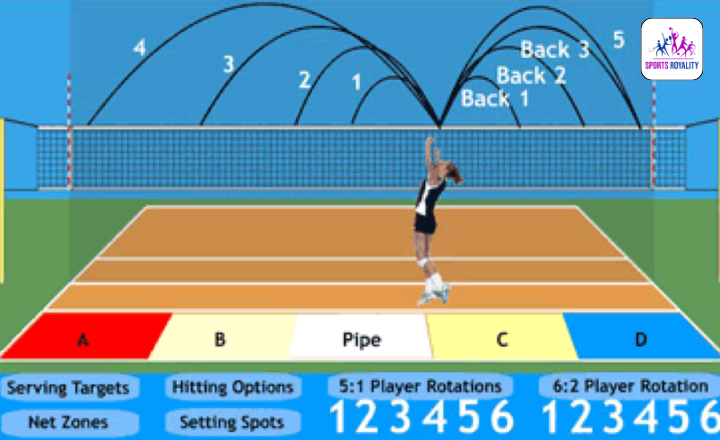
So many position-specific options can take your game to the next level. One option that is often overlooked is the libero position. The libero is a defensive specialist who can replace any back-row player without counting as a substitution and can excel at digging and passing.
This unique position allows for more flexibility on defense and takes the pressure off other players, allowing them to focus on their specific roles.
A position-specific option that can make a big impact is the setter. The setter’s primary job is to set up their teammates for successful attacks, but they also play a significant role in determining the tempo and flow of the game.
A skilled setter can strategically distribute plays to exploit weaknesses in the opposing team’s defense, keeping them on their toes and opening up opportunities for kills. A strong setter improves offensive efficiency and enhances team chemistry as players learn to work together effectively.
Let’s not forget about the middle blocker position. While all positions require specialized skills, being a middle blocker requires quick reflexes and excellent timing. Their main role is blocking opposing hitters at the net, which can drastically disrupt an opponent’s offensive strategy.
Middles also contribute offensively by executing quick attacks called “slides,” adding another dynamic element to their game.
More Bounce for High Flyers
Asics has been a dominant force in volleyball shoes, especially with their popular Sky Elite F.F.s. These shoes are known for their exceptional performance on the court, providing players with stability and comfort. When comparing them to basketball shoes like the Lebron 18 or Air Zoom G.T. Jump, there is simply no competition.
Basketball shoes are designed specifically for the demands of the game, which often involve explosive jumps and quick lateral movements. The Lebron 18, for instance, features a full-length Air Max unit that provides unparalleled cushioning and responsiveness.
It means high flyers on the volleyball court might find themselves longing for that extra bounce basketball shoes offer.
The Air Zoom G.T. Jump is another remarkable shoe that stands out regarding energy return and support. Equipped with Nike’s signature Zoom Air technology and a lightweight design, these shoes allow players to effortlessly soar through the air while maintaining optimal stability during landings.
Expanding your search beyond volleyball-specific brands could be a game-changer if you’re a high flyer looking for more bounce in your game.
Better Cushioning For Frequent Flyers
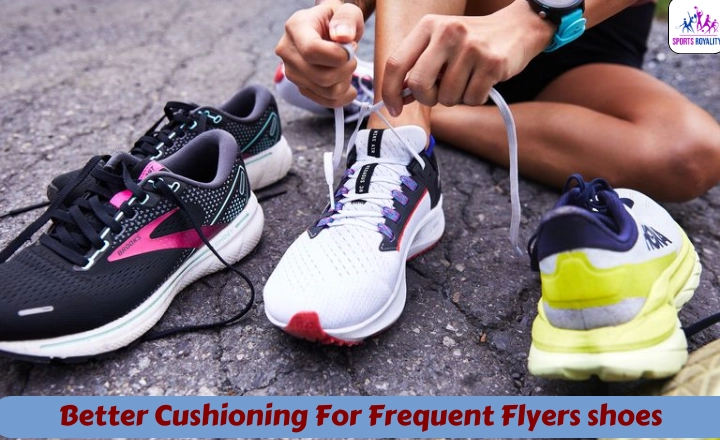
As frequent flyers, we often disregard the impact of poor shock absorption on our joints. We tend to focus on the discomfort in our knees but fail to recognize that our ankles, hips, and back are also affected. The stress caused by inadequate cushioning can lead to long-term joint problems and chronic pain.
But what if there was a solution? Better cushioning for frequent flyers could significantly reduce the stress on our joints during travel. Imagine stepping onto a plane and feeling instant relief as your feet sink into a plush, cushioned floor. Your body would thank you as it absorbs the shock from each step instead of transferring it directly to your joints.
Investing in better shock-absorbing materials for airline cabins could revolutionize how we experience air travel. Not only would it alleviate discomfort during flights, but it would also contribute to long-term joint health for those who frequently take to the skies.
It’s time we prioritize our well-being and demand better cushioning – not just for comfort’s sake but for the sake of our shoes.
Basketball Are More Affordable
There is undoubtedly a market for high-end, top-of-the-line footwear endorsed by professional athletes; the reality is that you don’t have to break the bank to get a decent pair of basketball shoes. The average price of a good-quality pair is surprisingly affordable.
One reason why basketball shoes are more affordable than their pricier counterparts is competition. With so many brands and models on the market, manufacturers understand that they need to offer competitive prices to attract customers and stand out from their competitors.
This healthy level of competition has resulted in various options at different price points, making it easier for consumers to find a good-quality shoe within their budget.
Advancements in technology have also contributed to more affordable basketball shoe options. Innovations such as lightweight materials, improved cushioning systems, and durable outsoles can now be found in mid-range shoes at lower prices than just a few years ago.
It means that even if you’re unwilling or able to splurge on top-tier footwear, you can still enjoy the benefits of well-designed and excellent-performing basketball shoes without breaking your bank account.
The Difference between Volleyball & Basketball Shoes
While volleyball and basketball shoes are designed for indoor sports and provide crucial support and traction, several vital differences make them unique.
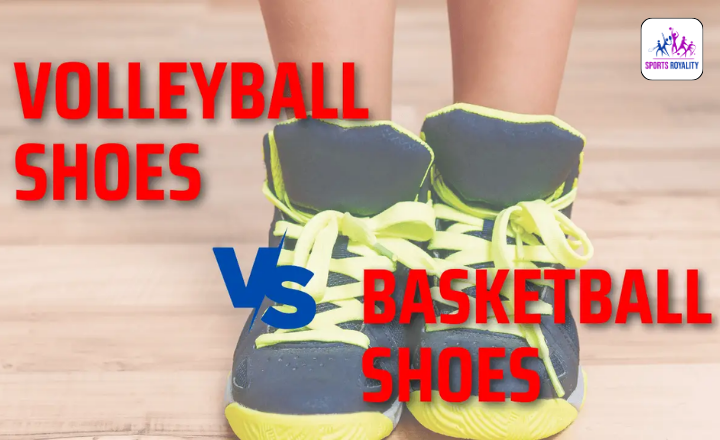
Materials
While it is true that basketball and volleyball shoes share many common materials, subtle differences in their construction significantly impact performance. A difference is the type of cushioning used in these shoes.
Basketball shoes typically feature thicker, more responsive foam midsoles to absorb impact during high-intensity jumps and quick lateral movements. Volleyball shoes prioritize lightweight foam cushioning to provide a balanced mix of support and agility on the court.
Weight
A critical difference between volleyball and basketball shoes lies in their weight. Basketball shoes tend to be heavier than their volleyball counterparts. This is largely due to the design elements that basketball shoes incorporate.
Basketball shoes typically have higher uppers, which provide extra ankle support and stability on the court. They often have thicker midsoles with added cushioning for impact protection during intense jumping and landing movements.
Volleyball shoes are designed to be lightweight and agile, prioritizing quick movements and responsiveness over excessive support, which helps run. Lightweight shoes are helpful for Running shoes.
The lighter weight of volleyball shoes allows players to move more freely on the court, making rapid changes in direction and executing explosive jumps without feeling weighed down by heavy footwear.
This advantage in maneuverability can prove crucial in a fast-paced sport like volleyball, where split-second reactions can make all the difference.
Cushioning
The difference in cushioning between volleyball and basketball shoes lies in the thickness of the midsole. Volleyball shoes are designed to offer less cushioning, resulting in a thinner profile compared to basketball shoes. This variation is due to the distinct demands of these sports and how they impact the foot.
Volleyball players require quick movements on a hard surface; hence, having a thinner midsole that offers minimal cushioning helps improve stability and responsiveness. It allows players to feel more connected to the ground and precisely make controlled movements.
Basketball involves more jumping and explosive movements, which puts a greater strain on joints. Basketball shoes typically have thicker midsoles that provide superior shock absorption to protect the feet from repetitive impact injuries.
Variety & Availability
One reason for the discrepancy in variety and availability between volleyball and these shoes could be the disparity in popularity between the two sports. Basketball has a massive global following compared to volleyball, which limits the market demand for specialized volleyball footwear.
Marketing efforts by major shoe manufacturers tend to favor basketball due to its large consumer base. There are fewer options available when it comes to choosing high-quality volleyball-specific footwear. This scarcity of variety shouldn’t discourage volleyball players from seeking suitable options.
It opens up an opportunity for innovation within the industry itself. Smaller brands specializing in niche sports like volleyball have emerged with unique designs tailored explicitly toward maximizing performance on the court.
By exploring these alternatives and supporting independent manufacturers catering to their needs, players can find specialized footwear that matches their requirements perfectly.
Which Basketball Shoes Are Best For Volleyball?
When choosing basketball shoes for volleyball, there are a few key factors to consider.
It’s essential to look for shoes that provide excellent traction on the court. Volleyball requires quick movements and sudden changes in direction, so having shoes with a grippy outsole is essential. Look for shoes that have multidirectional patterns on the sole for maximum grip.
Another crucial factor is ankle support. While basketball involves a lot of jumping and landing, volleyball players need more lateral stability due to frequent side-to-side movements. Look for basketball shoes with supportive midsoles and sturdy upper materials to stabilize your ankles during quick lateral movements.
Consider the weight of the basketball shoe. In volleyball, lightweight footwear can enhance your performance by allowing you to move quickly and efficiently across the court. Look for basketball shoes made from lightweight materials without compromising durability.
Some of the best basketball shoes for volleyball include options such as the Nike Kyrie 7, Adidas Harden Vol 5, or Under Armour Curry 8. These models offer optimal traction, ankle support, and lightweight design – all essential features to excel on the volleyball court!
Are High Tops Good For Volleyball?
This question has been debated among volleyball players and experts for years. While some argue that low-top shoes offer better mobility and agility, others believe that high tops provide the necessary support and stability to excel in certain positions, such as middle blocker and opposite.
Nike Air Zoom G.T. Jumps is a prime example of high-top shoes for volleyball players requiring extra ankle support. Middle blockers and opposites often make explosive movements, such as landing from blocks or executing powerful attacks.
These positions demand quick lateral movements, vertical jumps, and sudden changes in direction on-court. In such scenarios, having a shoe that provides ample ankle support can be beneficial in preventing injuries caused by overpronation or rolling of the ankles.
High tops like the Nike Air Zoom G.T. Jumps offer a secure fit around the ankle, reducing the risk of sprains while enabling athletes to perform at their best.
High-top shoes can enhance an athlete’s jumping ability by enhancing proprioception and muscle activation around the ankles. The added stability these shoes provide allows players to feel confident while exerting maximum power during takeoffs for attacking or blocking shots at the net. The locked-in feeling offered by high tops gives middle blockers an advantage in winning crucial jousts at the net against opposing hitters.
Things To Avoid When Looking For These Shoes For Volleyball: When searching for these shoes to wear during volleyball games, there are a few key things that you should avoid.
Excessive Heel Caging
One thing to avoid when looking for basketball shoes for volleyball is excessive heel caging. While some of these shoes are designed with heavy materials and thick padding around the heel to provide extra stability during jumps, this can be detrimental in volleyball.
Volleyball players rely on quick movements and agility, and excessive heel caging can restrict their range of motion. It can also cause discomfort and even lead to injuries such as ankle sprains.
Instead of opting for heavily caged heels, look for shoes that offer a balance between support and flexibility. Look for designs that focus on lightweight construction and provide ample cushioning without sacrificing mobility.
Shoes with strategic reinforcements in the midfoot area may be beneficial in providing stability while allowing for natural movement in the heel. Finding the right balance between support and agility will enhance your performance on the volleyball court.
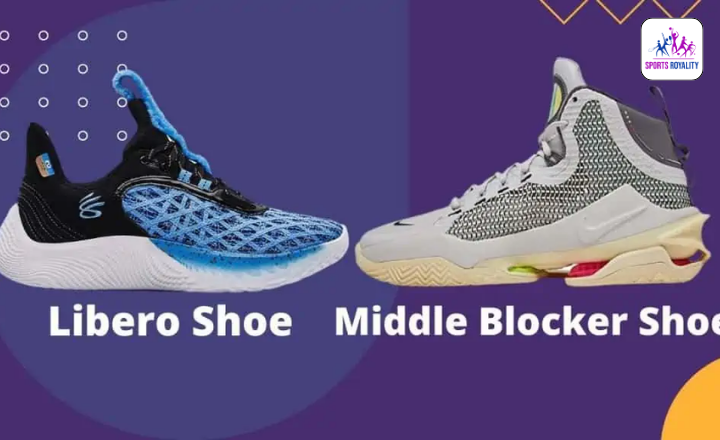
Excessive Weight
One thing that should be avoided when looking for basketball shoes for volleyball is excessive weight. Volleyball is a sport that requires quick movements and agility, and heavy shoes can hinder your performance on the court.
When shopping for basketball shoes, look for lightweight options that offer flexibility and support without weighing you down. Excessive weight in these shoes can slow you down and increase the risk of injuries.
Moving swiftly around the court requires a certain level of mobility, and heavy shoes can restrict your range of motion. Choosing shoes that prioritize lightness without compromising other essential features, such as cushioning and stability, is crucial.
Thin Midsole/Weak Cushioning
Instead of settling for inadequate midsoles and cushioning, opt for basketball shoes specifically designed for volleyball. These shoes are typically equipped with thicker midsoles that provide enhanced shock absorption, protecting your feet from the impact of repetitive jumps and abrupt changes in direction.
Look for models with advanced cushioning technologies like Nike Air or Adidas Boost, which offer excellent energy returns and optimal support during intense games. Remember to uphold the importance of proper footwear when playing volleyball using basketball shoes.
Thin midsoles and weak cushioning may hinder your performance as they fail to absorb shock adequately and increase the risk of injuries. Invest in basketball shoes explicitly engineered for volleyball to reap the benefits of thicker midsoles and superior cushioning technologies. Your feet will thank you while you enjoy improved comfort and support, ultimately elevating your game on the court.
Can You Wear Volleyball Shoes For Basketball?
It’s not like we’re talking about wearing running shoes for volleyball, which is an entirely different story. Having played both sports for over a decade, I can confidently say that the choice of footwear matters tremendously in each discipline.
While some may argue that basketball and volleyball have similarities, it shouldn’t be much of an issue to wear volleyball shoes for basketball; I couldn’t disagree more.
Volleyball shoes are designed to provide stability, support, and flexibility necessary for quick lateral movements on the court. Basketball shoes prioritize cushioning and ankle support since the game involves frequent jumping and landing.
The differences in their design highlight the unique demands of each sport on footwork and player movement. Attempting to play basketball in volleyball shoes would be akin to driving a racecar off-road.
You can navigate your way around initially, but it won’t take long before you start encountering problems. The lack of adequate cushioning in volleyball shoes would result in discomfort during prolonged periods on hard indoor surfaces typical of most basketball courts.
Many volleyball shoe designs’ lower cut profile characteristics would not provide sufficient ankle support when defending or attacking aggressively.
One may occasionally get away with wearing multi-functional athletic shoes across similar sports with minimal impact on performance or injury risk; such is not the case when using volleyball-specific footwear for playing basketball.
Why Don’t Basketball Players Wear Volleyball Shoes?
There are several reasons why basketball players don’t typically opt for this choice.
Basketball footwear has been specifically designed to cater to the unique needs of basketball players. These shoes offer essential features like ankle support, stability, and cushioning that help players navigate the quick direction changes, explosive jumps, and relentless impact that is commonplace in the game.
Volleyball shoes do not provide the same protection and support needed for these high-intensity movements on a basketball court.
Considering the overwhelming popularity of basketball worldwide, it’s no surprise that an industry hundreds (if not thousands) of times larger than the volleyball shoe market exists solely dedicated to producing top-quality basketball-specific footwear.
This industry invests substantial resources into research and development to continually improve performance-enhancing features in basketball shoes. Such advanced technology would be absent from utilizing volleyball shoes in a competitive game where precision is crucial.
Wrapping Up: Can You Wear Basketball Shoes For Volleyball
In the above paragraphs, we have discussed this question: Can You Wear Basketball Shoes For Volleyball? We concluded that Volleyball requires specific features in a shoe, such as lightweight design, ankle support, and good traction on indoor court surfaces. Basketball shoes tend to be bulkier, with less emphasis on lateral movement and stability.
While they may offer cushioning and comfort, volleyball-specific shoes provide a different level of performance than volleyball-specific shoes. It is recommended that volleyball players invest in appropriate footwear to maximize their potential and prevent potential injuries on the court. So, next time you hit the volleyball court, choose the right shoes for optimal performance and safety.
FAQs
Will wearing basketball shoes affect my performance in volleyball?
Wearing basketball shoes for volleyball may limit your agility and increase the risk of injuries due to inadequate ankle support and lesser grip on the court.
Can I use my basketball sneakers interchangeably for both sports?
It’s recommended to use your basketball sneakers sparingly for both sports since their design and technology are tailored specifically to meet the demands of each sport.

